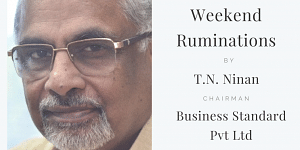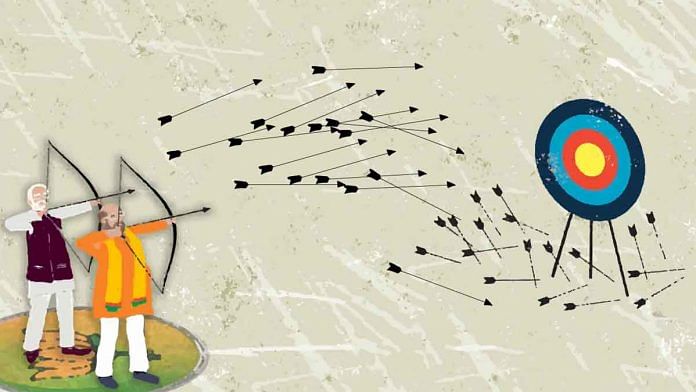While no election is over till the last vote is counted, the virtually uniform findings of opinion polls suggest that the Bharatiya Janata Party (BJP) will return to power, probably as the largest plurality and as part of a coalition. The party’s election manifesto, therefore, deserves close scrutiny, especially since many of the promises made in the 2014 manifesto have guided the Modi government’s actions — whether it is the thrust on digitisation and technology-based solutions, Swachh Bharat or cow protection.
 An important feature of the Narendra Modi approach to development is the focus on output rather than outcomes. Output is the number of railway lines electrified; outcome would be its impact on the speed and volume of railway freight and passenger traffic. Output would be the number of Jan Dhan accounts opened, outcome would be the number of transactions that actually take place in those accounts.
An important feature of the Narendra Modi approach to development is the focus on output rather than outcomes. Output is the number of railway lines electrified; outcome would be its impact on the speed and volume of railway freight and passenger traffic. Output would be the number of Jan Dhan accounts opened, outcome would be the number of transactions that actually take place in those accounts.
This is not to decry change in output — the pace of highway construction has made a difference to the country, obviously. Indeed, the Congress promise of filling 1.4 million vacant posts is a case of input without mention of output, let alone outcomes. But it should be obvious that output is not enough if it does not change outcomes — so not just the number of teachers or doctors (both are needed) but the impact on literacy and life expectancy, on which Bangladesh is now ahead of India. The UN’s Sustainable Development Goals are a useful example as they focus on outcomes.
Also read: BJP’s Rs 100 lakh crore infrastructure dream only possible with pvt help, financial reform
From this perspective, the manifesto is full of promises that have to do with output: Start 75 new medical colleges, establish a National Traders’ Welfare Board, achieve 10 per cent blending of ethanol in petrol, and so on. The focus on outcomes is, in comparison, a minor theme. When outcome targets are stated, they are so ambitious as to suggest little underlying analysis, or are simply unrealistic (double farmers’ incomes by 2022).
This is mentally lazy work. A serious attempt to take GDP from $2.7 trillion in 2018 to $5 trillion by 2025, as is promised, would involve achieving annual growth of over 9 per cent. What would it take to deliver this, especially when the manifesto points out that 7.3 per cent annual growth over the past five years is the fastest till now? There is no answer. The promise of making the country a manufacturing hub was held out in 2014, and is being held out again. So what different will be done to make the future deviate from the past? Or, how will exports be doubled in the next five years, when the last five have seen the slowest growth of merchandise exports in perhaps four decades?
The related feature of the manifesto is that, amidst its dozens of output targets and government programmes, there is little attention to policy. This anti-policy bias has been a feature of the Modi government, and the manifesto offers no change. There are good reasons why neither exports nor manufacturing has been a success story over the last five years; and why agriculture is a distress story. If those reasons are not spelt out and addressed, a manifesto falls short. Indian agriculture has moved from shortages to surpluses, but policy has not changed focus to facilitating agricultural exports or finding other ways to deal with surpluses — through food processing or crop diversification. If this is not understood, depressed prices for farm output cannot be given a boost. Promising interest-free loans to farmers, as the BJP does, is not an answer.
You could argue that a manifesto can spell out only so much, and in any case, it is not a think-tank monograph. That was precisely the response of a Congressman when asked for the details of how its big hand-out programme would work in practice. But if an election promise has to be credible, especially when it lays out a big spending package or seeks to deliver a change on the past record, silence on practical questions or on key policy issues does not help.
Also read: BJP & Congress manifestos offer a security policy high on emotions, low on substance
By Special Arrangement with Business Standard




When you talk about manifesto it’s all about confession to the words which is been kept or else its breach of trust towards the nation as a whole. There should be a rapid change in the economic system from ground level end of the day its not only the corporate world its public as a whole so should give equal importance.
A bit of an afterthought. The Congress managed to create a buzz around its Manifesto and the style with which it was released. Signalling it had caught up in Event Management. There was similar surprise when it covered the missile gap on social media, around the time of the Gujarat Assembly election. An incumbent’s Manifesto cannot stray much beyond its Report Card. A similar dilemma presents itself on the campaign trail, when there is virtually no mention of the previous campaign and the issues that had defined it.
An excellent article. A jump in GDP from $5 trillion in 2025 to $10 trillion in 2032 will require growth rate exceeding 10 % per annum. Furthermore, China’s GDP , which currently at around $14 trillion , will not remain static. So, catching up with China is a very distant dream.